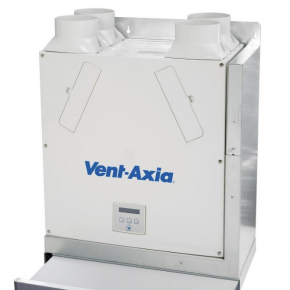
Vent-Axia welcomes ‘Indoor Air Quality at Home’ guidance from NICE
Leading British ventilation manufacturer Vent-Axia has welcomed the publication of guidance on ‘Indoor Air Quality at Home’ from the National Institute of Health and Care Excellence (NICE).
Following on from draft guidance published in July last year, the document provides detailed information and advice on how to reduce exposure to indoor pollutants and, in turn, protect health.
The publication of this guidance sets in stone the crucial importance of good indoor air quality (IAQ), highlighting the significant part effective ventilation plays in helping combat indoor air pollution in the home
With Public Health England attributing between 28,000 to 36,000 deaths a year from long-term exposure to air pollution, it is the biggest environmental threat to health in the UK.
NICE has taken a systematic approach to try and tackle indoor air pollution by offering guidance to the many stakeholders involved. ‘Indoor Air Quality at Home’ offers advice for action to local authorities, healthcare professionals, architects, designers and building developers, as well as the general public.
This robust document therefore aims to reduce the lives lost due to air pollution.
Jenny Smith, Head of Marketing at Vent-Axia (pictured below), commented: “At Vent-Axia we are committed to improving indoor air quality and so public health.

“Currently a staggering 65% of UK homes suffer from poor IAQ as a result of inadequate ventilation which has serious health implications for inhabitants. We are delighted to see that this latest guidance from NICE emphasises the crucial role good ventilation plays in improving IAQ and providing a healthy home environment.”
Confirming the critical role ventilation plays in removing potential pollutants and improving IAQ, the guidance advises people to ensure rooms are well ventilated by extractor fans, trickle vents, cooker hoods or by opening windows, especially when undertaking activities that lead to poor IAQ.
These activities include cooking, drying clothes inside, lighting open solid-fuel fires and candles, using cleaning products or solvents and paints, and having showers and baths.
Another key recommendation within the document is to reduce damp and condensation in the home. Condensation and mould is not a new problem, but improved insulation and air tightness of existing properties without considering ventilation is causing a rise in new cases.
Within the guidance NICE recommends using background ventilation; using mechanical ventilation where possible; opening windows where possible and safe to provide temporary increased ventilation; avoiding moisture producing activities, such as drying clothes inside; repairing sources of water damage; and removing any residual moisture when it forms.
The NICE guidance also includes advice for healthcare professionals to specifically communicate to vulnerable people who will be more affected by air pollution, such as pregnant women and people with respiratory or cardiovascular conditions.
This includes ensuring people understand the activities leading to poor IAQ and that indoor air pollutants can trigger or exacerbate conditions.
Meanwhile, for architects, designers and builders the NICE guidance recommends adopting a whole house approach to heating and ventilation. The aim is to help ensure IAQ is maintained to minimise household exposure to particulate matter, while achieving energy use standards.
When designing heating and ventilation systems the guidance therefore advises to include provision for removing indoor air pollutants through ventilation, including kitchen extractor fans or cooker hoods.
The guidance advises that any new dwellings should be built to minimise IAQ problems. Ventilation systems should also be designed to help avoid exposure to outdoor air pollution, including fitting mechanical ventilation with filtration.
For refurbishments permanent effective ventilation must be included alongside energy efficiency measures, which is a very important consideration. Correct installation and commissioning of ventilation, as well as ensuring accessibility for regular maintenance, are also highlighted as important factors.
For local authorities the NICE guidance advises prioritising IAQ and embedding plans for improving it into an existing plan or strategy. It also emphasises the need for a balanced approach to ventilation, insulation and heating to achieve good IAQ.
Landlords are also given guidance on how to ensure their properties have good IAQ and are advised to undertake maintenance programmes for ventilation.
To help protect health in the home, for many years now Vent-Axia has been working hard to provide ventilation solutions to improve IAQ for households. For new build homes, Vent-Axia’s Sentinel Kinetic mechanical ventilation with heat recovery (MVHR) system boasts an impressive 94% heat recovery.
Meanwhile, Vent-Axia’s Lo-Carbon Sentinel Kinetic Cooker Hood combines a cooker hood with MVHR unit in one. A vital part of an MVHR system is its filters. Inside an MVHR unit, fresh incoming air passes through a filter to remove pollen, debris and products of pollution.
Filters up to ISO ePM2.5 70% (F7 grade) ensure even homes in heavily urbanised areas can filter out most impurities, up to and including PM2.5 particles, for example diesel particulates.
To ensure MVHR systems run efficiently and effectively Vent-Axia also offers ventilation servicing to maintain the systems and check and replace filters as needed.
For private refurbishments, one solution is the Vent-Axia PureAir Sense which is the UK’s only bathroom fan with an odour sensor and has been designed to help offer peace of mind to households. Equipped with a pioneering odour sensor that increases airflow when the air is poor, the Vent-Axia PureAir Sense helps ensure a comfortable living environment.
For social housing refurbishments, there are number of options including: Positive input Ventilation, such as Vent-Axia’s Lo-Carbon Pozidry Pro PIV and Lo-Carbon PoziDry Compact Pro; and the Lo-Carbon Revive, an intelligent filter-less fan.
Latest news

28th March 2025
Ideal Heating Commercial announces 10-year warranty on Evomax 2 boiler
Evomax 2, the UK’s number one selling commercial wall-mounted boiler from Ideal Heating Commercial, is now available with a 10-year warranty.
Posted in Articles, Building Industry News, Building Products & Structures, Building Regulations & Accreditations, Building Services, Facility Management & Building Services, Heating Systems, Controls and Management, Heating, Ventilation and Air Conditioning - HVAC, Innovations & New Products, Pipes, Pipes & Fittings, Plumbing, Retrofit & Renovation, Sustainability & Energy Efficiency, Videos
28th March 2025
FLIR Si1-LD Acoustic Imaging Camera for Compressed Air Leak Detection
FLIR, a Teledyne Technologies company, introduces the Si1-LD, an industrial acoustic imaging camera that brings faster and more accurate compressed air leak detection to those operating on a modest condition monitoring budget.
Posted in Acoustics, Noise & Vibration Control, Articles, Building Industry News, Building Products & Structures, Building Services, Facility Management & Building Services, Information Technology, Innovations & New Products, Retrofit & Renovation, Sustainability & Energy Efficiency, Thermal Imaging and Monitors
28th March 2025
LIFTEX 2025 Seminar programme announced
Registration has opened for LIFTEX 2025. Now in its 37th year, LIFTEX 2025 is the UK’s only dedicated exhibition for the lift, escalator and access industry and takes place only once every three years.
Posted in Access Control & Door Entry Systems, Accessibility, Articles, Building Industry Events, Building Industry News, Building Products & Structures, Building Regulations & Accreditations, Building Services, Exhibitions and Conferences, Facility Management & Building Services, Health & Safety, Retrofit & Renovation, Security and Fire Protection, Seminars
28th March 2025
MCRMA welcomes ArcelorMittal UK to membership
A UK division of the global steelmaking business ArcelorMittal has become the latest new member of the MCRMA, the industry association representing the metal building envelope sector.
Posted in Articles, Building Associations & Institutes, Building Industry News, Building Products & Structures, Building Systems, Cladding, Facades, Posts, Restoration & Refurbishment, Retrofit & Renovation, Roofs, Steel and Structural Frames, Walls
 Sign up:
Sign up: